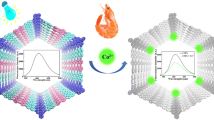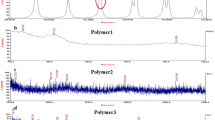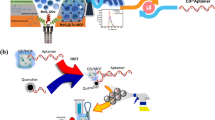Abstract
Zinc and cadmium are two main transition metal ions and play profound important roles in environmental and human health. But the distinctive detection of these two ions is still challenging since they belong to the same periodic group and have similar chemical properties. A fluorescent bipyridine-based porous organic polymer (Bpy-POP) containing aggregation caused quenching (ACQ) units (anthracene) and metal ions recognition units (bipyridine) was synthesized through the Schiff base condensation reaction. In the DMF/H2O mixtures with the water fractions of 90%, the Bpy-POP aggregated and the fluorescent Bpy-POP quenched subsequently due to the ACQ effect of anthracene in the skeleton (“OFF” state). With the addition of Zn2+ or Cd2+, however, the strong coordination of the bipyridine units from the adjacent Bpy-POPs with Zn2+ or Cd2+ induced the partial dispersion of large Bpy-POP aggregates. Consequently, the fluorescence intensities enhanced dramatically as well as the fluorescence emission shifted to redder region, showing an “ON” state. Combing the fluorescence increasing efficiency and the maximum emission wavelength shift degree together, Zn2+ and Cd2+ can be selectively discriminated and quantitatively detected, which exhibits a great promising of the present Bpy-POP based method in Zn2+ and Cd2+ monitoring in real samples.





Similar content being viewed by others
References
Wang P, Xue S, Yang X. A novel peptide-based fluorescent chemosensor for detection of zinc (II) and copper (II) through differential response and application in logic gate and bioimaging. Microchem J. 2020;158:105147.
Loisel E, Jacquamet L, Serre L, Bauvois C, Ferrer JL, Vernet T, Guilmi AMD, Durmort C. A new pneumococcal Zn-binding protein homologous with ABC transporters: biochemical and structural analysis. Mol Biol. 2008;381:594–606.
Bobilya DJ, Reynolds JT, Faia KL, Briske-Anderson M, Reeves PG. Zinc-related metallothionein metabolism in bovine pulmonary artery endothelial cells. J Nutr Biochem. 1999;10:139–45.
Lai J, Moxey A, Nowak G, Vashum K, Bailey K, McEvoy M. The efficacy of zinc supplementation in depression: systematic review of randomised controlled trials. J Affective Disord. 2012;136:31–9.
Chen TT, Tian X, Liu CL, Ge J, Chu X, Li Y. Fluorescence activation imaging of cytochrome C released from mitochondria using aptameric nanosensor. J Am Chem Soc. 2015;137:982–9.
Weiss JH, Sensi SL, Koh JY. Zn2+: a novel ionic mediator of neural injury in brain disease. Science. 2000;21:395–401.
Ymélé E, Jiokeng SLZ, Nde DB, Kamgaing T, Tonlé IK. Simultaneous voltammetric determination of Cd2+, Pb2+, and Hg2+ ions using aminosepiolite-coated glassy carbon electrode: Optimization of detection parameters via response surface methodology. J Anal Test. 2019;3:295–305.
Shi ZH, Han QX, Yang LZ, Tang XL, Dou W, Li Z, Shao YG, Shao YL, Guan LP, Liu WS. A highly selective two-photon dluorescent probe for setection of Cadmium (II) based on intramolecular electron transfer and its imaging in living cells. Chem Eur J. 2015;21:290–7.
Tuerkmen M, Ciminli C. Determination of metals in fish and mussel species by inductively coupled plasma-atomic emission spectrometry. Food Chem. 2007;103(2):670–5.
Liang Q, Jing H, Gregoire DC. Determination of trace elements in granites by inductively coupled plasma mass spectrometry. Talanta. 2000;51(3):507–13.
Khalida K, Muhammad N. Simultaneous determination of accumulated hazardous metals in hen`s egg by atomic absorption spectroscopy. J Appl Sci. 2006;6(1):198–201.
Lin Q, Lu TT, Zhu X, Wei TB, Li H, Zhang YM. Rationally introduce multi-competitive binding interactions in supramolecular gels: a simple and efficient approach to develop multi-analyte sensor array. Chem Sci. 2016;7:5341–6.
Li W, Liu Z, Fang B, Jin M, Tian Y. Two-photon fluorescent Zn2+ probe for ratiometric imaging and biosensing of Zn2+ in living cells and larval Zebrafish. Biosens Bioelectron. 2020;148:111666.
Garau A, Lvova L, Macedi E, Ambrosi G, Aragoni MC, Arca M, Caltagirone C, Coles SJ, Formica M, Fusi V, Giorgi L, Isaia F, Lippolis V, Ortond JB, Paolesse R. N2S2 pyridinophane-based fluorescent chemosensors for selective optical detection of Cd2+ in soils. New J Chem. 2020;44:20834–52.
Hong Y, Chen S, Leung CWT, Lam JWY, Liu J, Tseng N-W, Kwok RTK, Yu Y, Wang Z, Tang BZ. Fluorogenic Zn(II) and chromogenic Fe(II) sensors based on terpyridine-substituted tetraphenylethenes with aggregation-induced emission characteristics. ACS Appl Mater Interfaces. 2011;3:3411–8.
Li J, Chen Y, Chen T, Qiang J, Zhang Z, Wei T, Zhang W, Wang F, Chen X. A benzothiazole-based fluorescent probe for efficient detection and discrimination of Zn2+ and Cd2+, using cysteine as an auxiliary reagent. Sensor Actuat B-Chem. 2018;268:446–55.
Tan Y, Gao J, Yu J, Wang Z, Cui Y, Yang Y, Qian G. A new fluorescent probe for distinguishing Zn2+ and Cd2+ with high sensitivity and selectivity. Dalton Trans. 2013;42:11465–70.
Zhang Y, Chen X, Liu J, Gao G, Zhang X, Hou S, Wang H. A highly selective and sensitive fluorescent chemosensor for distinguishing cadmium(II) from zinc(II) based on amide tautomerization. New J Chem. 2018;42:19245–51.
Shi X, Meng HM, Geng X, Qu L, Li Z. DNAzyme–metal-organic framework: two-photon nanoprobe for in situ monitoring of apoptosis-associated Zn2+ in living cells and tissues. ACS Sens. 2020;5(10):3150–7.
Song H, Zhang Z. A quinoline-based ratiometric fluorescent probe for discriminative detection of Zn2+ and Cd2+ with different binding modes, and its Zn2+ complex for relay sensing of pyrophosphate and adenosine triphosphate. Dyes Pigments. 2019;165:172–81.
Xu J, Xiong J, Qin Y, Li Z, Pan C, Huo Y, Zhang H. A novel quinolinyl-tetraphenylethene-based fluorescence ‘“turn-on”’ sensor for Zn2+ with a large Stokes shift and its applications for portable test strips and biological imaging. Mater Chem Front. 2020;4:3338–48.
Peng S, Lv J, Liu G, Fan C, Pu S. A photochromic diarylethene-functionalized fluorescent probe for Cd2+ and Zn2+ detections. Tetrahedron. 2020;76:131618.
Takashima I, Inoue Y, Matsumoto N, Takagi A, Okuda K. A fluorogenic probe using a catalytic reaction for the detection of trace intracellular zinc. Chem Commun. 2020;56:13327–30.
Ghosh M, Ta S, Banerjee M, Mahiuddin M, Das D. Exploring the scope of photoinduced electron transfer-chelation-enhanced fluorescence-fluorescence resonance energy transfer processes for recognition and discrimination of Zn2+, Cd2+, Hg2+, and Al3+ in a ratiometric manner: application to sea fish analysis. ACS Omega. 2018;3:4262–75.
Erdemir S, Kocyigit O. Dual recognition of Zn2+ and Al3+ ions by a novel probe containing two fluorophore through different signaling mechanisms. Sensor Actuator B-Chem. 2018;273:56–61.
Zhang T, Mu L, She G, Shi W. 2 × 2 Fluorescent sensor array based on SiNWs for analysis of Pb2+, Cd2+, Cr3+ and Hg2+. J Lumin. 2019;209:267–73.
Wang Y, Wang WW, Xue WZ, Wu WN, Zhao XL, Xu ZQ, Fan YC, Xu ZH. A simple hydrazone as a fluorescent turn-on multianalyte (Al3+, Mg2+, Zn2+) sensor with different emission color in DMSO and resultant Al3+ complex as a turnoff sensor for F− in aqueous solution. J Lumin. 2019;212:191–9.
Ding SY, Dong M, Wang YW, Chen YT, Wang HZ, Su CY, Wang W. Thioether-based fluorescent covalent oganic framework for selective detection and facile removal of mercury(II). J Am Chem Soc. 2016;138:3031–7.
Xu MM, Kong XJ, He T, Wu XQ, Xie LH, Li JR. A stable Zr(IV)-based metal−organic framework constructed from C=C bridged di-isophthalate ligand for sensitive detection of Cr2O7 2− in water. Inorg Chem. 2018;57:14260–8.
Li Z, Zhang Y, Xia H, Mu Y, Liu X. A robust and luminescent covalent organic framework as a highly sensitive and selective sensor for the detection of Cu2+ ions. Chem Commun. 2016;52:6613–6.
Hao JN, Ya B. A water-stable lanthanide-functionalized MOF as a highly selective and sensitive fluorescent probe for Cd2+. Chem Commun. 2015;51:7737–40.
Gu X, Zhang G, Zhang D. A new ratiometric fluorescence detection of heparin based on the combination of the aggregation-induced fluorescence quenching and enhancement phenomena. Analyst. 2011;137(2):365–9.
Wu X, Guo J, Quan Y, Jia W, Jia D, Chen Y, Xie Z. Cage carbon-substitute does matter for aggregation-induced emission features of o-carborane-functionalized anthracene triads. J Mater Chem C. 2018;6:4140–9.
Kong L, Chen Y, Ye W, Zhao L, Song B, Yang JX, Tian YP, Tao XT. Synthesis, characterization, optical property of a bipyridine derivative and its application to determine trace Zn2+ in water. Sensor Actuator B-Chem. 2013;177:218–23.
Mcmanus GJ, Iv JJP, Perry M, Wagner BD, Zaworotko MJ. Exciplex fluorescence as a diagnostic probe of structure in coordination polymers of Zn2+ and 4,4’-bipyridine containing intercalated pyrene and enclathrated aromatic solvent guests. J Am Chem Soc. 2007;129(29):9094–10101.
Croitor L, Coropceanu EB, Jeanneau E, Dementiev IV, Goglidze TI, Chumakov YM, Fonari MS. Anion-induced generation of binuclear and polymeric Cd(II) and Zn(II) coordination compounds with 4,4’-bipyridine and dioxime ligands. Cryst Growth Des. 2009;9(12):5233–43.
Halder A, Karak S, Addicoat M, Bera S, Chakraborty A, Kunjattu SH, Pachfule P, Heine T, Banerjee R. Ultra-stable imine-based covalent organic frameworks for sulfuric acid recovery: an effect of interlayer hydrogen bonding. Angew Chem Int Ed. 2018;57(20):5797–5802.
Aravindan P, Sivaraj K, Kamal C, Vennila P, Venkatesh G. Synthesis, molecular structure, spectral characterization, molecular docking and biological activities of (E)-N-(2-methoxy benzylidene) anthracene-2-amine and Co(II), Cu(II) and Zn(II) complexes. J Mol Struc. 2021;1232:130035.
Acknowledgements
This work is supported by the National Natural Science Foundation of China (22064001, 41361088), Opening fund of Fundamental Science on Radioactive Geology and Exploration Technology Laboratory (RGET1810).
Author information
Authors and Affiliations
Contributions
Y.N. Wu and A.T. Qiu carried out the discrimination and detection of Zn2+ and Cd2+, Z. Q. Zhong and L. Z. Wang carried out the synthesis of BPY-POP, M. Y. Yuan and J. Guo participated in the preparation of manuscript and discussion, H. X. Zhao carried out the characterization of BPY-POP, S. J. Xiao prepared the manuscript and particapated in the discussion. All authors read and approved the final manuscript.
Corresponding author
Ethics declarations
Conflicts of Interest
The authors declare that they have no competing interests.
Supplementary Information
Below is the link to the electronic supplementary material.
About this article
Cite this article
Wu, YN., Qiu, AT., Zhong, ZQ. et al. Selective and Sensitive Discrimination of Zinc and Cadmium Based on a Novel Fluorescent Porous Organic Polymer. J. Anal. Test. 5, 235–241 (2021). https://doi.org/10.1007/s41664-021-00193-w
Received:
Accepted:
Published:
Issue Date:
DOI: https://doi.org/10.1007/s41664-021-00193-w




